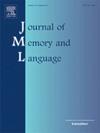Toddlers’ looking behaviours during referent selection and relationships with immediate and delayed retention
IF 2.9
1区 心理学
Q1 LINGUISTICS
引用次数: 0
Abstract
The current study investigates whether children’s attempts to solve referential ambiguity is best explained as a process-of-elimination or a novelty bias. We measured 2.5-year-old children’s pointing and eye movements during referent selection trials and assessed whether this changes across repeated exposures. We also tested children’s retention of novel words and how much focusing on novel targets during referent selection supports immediate and delayed retention as well as the effect of hearing the words ostensively named after referent selection. Time course analyses of children’s looking during referent selection indicated that soon after noun onsets, in familiar target trials there was a greater focus on targets relative to chance, but in novel target trials, children focussed on targets less than chance, suggesting an initial focus on competitors. Children also took longer to focus on and point to novel compared to familiar targets. Thus, this converging evidence suggests referent selection is best described as a process-of-elimination. Ostensive naming also led to faster pointing at novel targets in subsequent trials and better delayed retention than the non-ostensive condition. In addition, a greater focus on novel targets during referent selection was associated with better immediate retention for the ostensive naming condition, but better delayed retention for the non-ostensive condition. Therefore, a focus on novelty may supplement weaker encoding, facilitating later retention.

幼儿在指称选择过程中的注视行为及其与即时记忆和延迟记忆的关系
目前的研究调查了儿童解决指称歧义的尝试是否最好解释为消除过程或新颖性偏见。我们在参照选择试验中测量了2.5岁儿童的指向和眼球运动,并评估了这种运动是否会在重复暴露中发生变化。我们还测试了儿童对新单词的记忆,以及在指称选择过程中对新目标的关注程度对即时和延迟记忆的支持程度,以及听到指称选择后的假名单词的影响。对儿童在指称物选择过程中寻找的时间过程分析表明,名词出现后不久,在熟悉的目标试验中,儿童对目标的关注程度高于对偶然的关注,而在新颖的目标试验中,儿童对目标的关注程度低于偶然的关注,这表明儿童最初关注的是竞争对手。与熟悉的目标相比,孩子们也需要更长的时间来关注和指向新的目标。因此,这些趋同的证据表明,参照选择最好被描述为一个淘汰的过程。在随后的试验中,与非明示条件相比,所指命名还能更快地指向新目标,并能更好地延迟记忆。此外,在指称选择过程中,对新目标的更多关注与在实指条件下更好的即时记忆有关,而在非实指条件下更好的延迟记忆有关。因此,对新颖性的关注可能会补充较弱的编码,促进以后的记忆。
本文章由计算机程序翻译,如有差异,请以英文原文为准。
求助全文
约1分钟内获得全文
求助全文
来源期刊
CiteScore
8.70
自引率
14.00%
发文量
49
审稿时长
12.7 weeks
期刊介绍:
Articles in the Journal of Memory and Language contribute to the formulation of scientific issues and theories in the areas of memory, language comprehension and production, and cognitive processes. Special emphasis is given to research articles that provide new theoretical insights based on a carefully laid empirical foundation. The journal generally favors articles that provide multiple experiments. In addition, significant theoretical papers without new experimental findings may be published.
The Journal of Memory and Language is a valuable tool for cognitive scientists, including psychologists, linguists, and others interested in memory and learning, language, reading, and speech.
Research Areas include:
• Topics that illuminate aspects of memory or language processing
• Linguistics
• Neuropsychology.

 求助内容:
求助内容: 应助结果提醒方式:
应助结果提醒方式:


